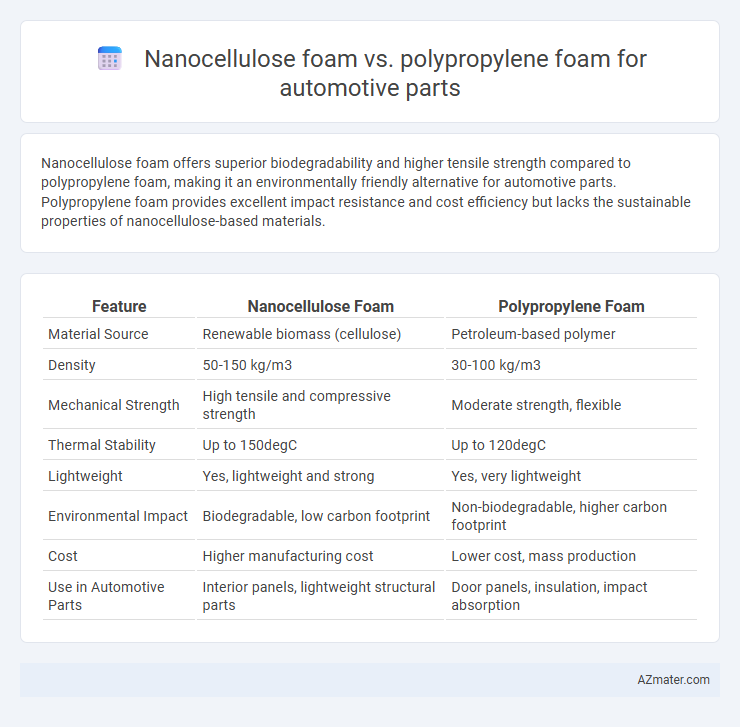Nanocellulose foam offers superior biodegradability and higher tensile strength compared to polypropylene foam, making it an environmentally friendly alternative for automotive parts. Polypropylene foam provides excellent impact resistance and cost efficiency but lacks the sustainable properties of nanocellulose-based materials.
Table of Comparison
| Feature | Nanocellulose Foam | Polypropylene Foam |
|---|---|---|
| Material Source | Renewable biomass (cellulose) | Petroleum-based polymer |
| Density | 50-150 kg/m3 | 30-100 kg/m3 |
| Mechanical Strength | High tensile and compressive strength | Moderate strength, flexible |
| Thermal Stability | Up to 150degC | Up to 120degC |
| Lightweight | Yes, lightweight and strong | Yes, very lightweight |
| Environmental Impact | Biodegradable, low carbon footprint | Non-biodegradable, higher carbon footprint |
| Cost | Higher manufacturing cost | Lower cost, mass production |
| Use in Automotive Parts | Interior panels, lightweight structural parts | Door panels, insulation, impact absorption |
Introduction to Automotive Foams
Automotive foams like nanocellulose foam and polypropylene foam serve crucial roles in enhancing vehicle comfort, safety, and durability. Nanocellulose foam offers superior biodegradability, lightweight properties, and high mechanical strength compared to conventional polypropylene foam. Polypropylene foam remains favored for its cost-effectiveness, excellent impact absorption, and resistance to chemicals and moisture in automotive applications.
Overview of Nanocellulose Foam
Nanocellulose foam offers exceptional lightweight strength and superior thermal insulation properties compared to polypropylene foam, making it increasingly popular in automotive applications. Derived from renewable cellulose fibers, nanocellulose foam exhibits enhanced biodegradability and sustainability, addressing environmental concerns in vehicle manufacturing. Its high surface area and mechanical durability contribute to improved impact resistance and noise reduction, features critical for automotive parts performance.
Properties of Polypropylene Foam
Polypropylene foam exhibits low density, excellent chemical resistance, and superior impact absorption, making it a widely used material in automotive parts for vibration damping and insulation. Its thermal stability ranges typically between -20degC to 110degC, ensuring durability under varying temperature conditions in vehicles. The closed-cell structure of polypropylene foam enhances moisture resistance and maintains structural integrity, vital for long-term automotive applications.
Comparative Mechanical Strength
Nanocellulose foam exhibits superior tensile strength and impact resistance compared to polypropylene foam, making it a more durable choice for automotive parts subject to stress. Its higher stiffness-to-weight ratio enhances structural integrity while reducing overall vehicle weight. Polypropylene foam, although lightweight and cost-effective, tends to have lower mechanical strength and less resistance to deformation under load.
Lightweight Performance in Vehicles
Nanocellulose foam exhibits superior lightweight performance compared to polypropylene foam in automotive parts, offering a lower density of approximately 0.02-0.1 g/cm3 versus polypropylene's typical 0.9-0.95 g/cm3. Its high strength-to-weight ratio enables significant weight reduction in vehicle components, contributing to enhanced fuel efficiency and reduced emissions. Nanocellulose foam also provides better mechanical resilience and improved energy absorption, making it an optimal material for lightweight, sustainable automotive applications.
Sustainability and Environmental Impact
Nanocellulose foam exhibits superior sustainability compared to polypropylene foam in automotive applications due to its biodegradable nature and derivation from renewable cellulose sources. It significantly reduces carbon footprint and environmental pollution, as it decomposes naturally without releasing toxic microplastics, unlike polypropylene foam, which relies on petroleum-based polymers and contributes to long-term waste accumulation. Implementing nanocellulose foam in automotive parts supports circular economy principles by enabling easier recycling and decreasing dependency on fossil fuels.
Thermal and Acoustic Insulation
Nanocellulose foam exhibits superior thermal insulation with a low thermal conductivity of about 0.03 W/m*K, making it highly effective in reducing heat transfer in automotive parts compared to polypropylene foam, which typically has thermal conductivity around 0.1 W/m*K. In terms of acoustic insulation, nanocellulose foam provides enhanced sound absorption due to its porous network and high surface area, outperforming polypropylene foam's relatively rigid and less porous structure. The biodegradability and lightweight nature of nanocellulose foam also contribute to improved sustainability and fuel efficiency in automotive applications.
Manufacturing and Cost Efficiency
Nanocellulose foam offers superior sustainability and lightweight properties compared to polypropylene foam, with manufacturing processes that emphasize renewable materials and lower environmental impact. Although polypropylene foam benefits from mature, low-cost mass production techniques, nanocellulose foam's emerging scalable fabrication methods aim to reduce processing complexity and energy consumption. Cost efficiency in automotive parts production increasingly favors nanocellulose foam as advancements lower raw material expenses and enhance recyclability, aligning with industry demands for eco-friendly and high-performance alternatives.
Application Case Studies in Automotive Industry
Nanocellulose foam demonstrates superior lightweight and biodegradable properties compared to polypropylene foam, making it ideal for automotive interior components like door panels and headliners, as evidenced by multiple case studies at companies such as Toyota and Ford. These studies highlight nanocellulose's enhanced mechanical strength and thermal insulation, contributing to improved vehicle fuel efficiency and reduced environmental impact. Polypropylene foam remains prevalent for structural parts due to cost-effectiveness but shows limitations in sustainability and biodegradability compared to advanced nanocellulose alternatives.
Future Trends in Automotive Foam Technologies
Nanocellulose foam exhibits superior sustainability and biodegradability compared to polypropylene foam, making it a pivotal material in the shift towards eco-friendly automotive parts. Innovations in nanocellulose processing enhance mechanical strength and thermal insulation, addressing automotive industry demands for lightweight and energy-efficient materials. The future of automotive foam technologies leans towards bio-based composites like nanocellulose foam, driven by regulatory pressures and consumer preferences for greener vehicle components.

Infographic: Nanocellulose foam vs Polypropylene foam for Automotive Part
 azmater.com
azmater.com